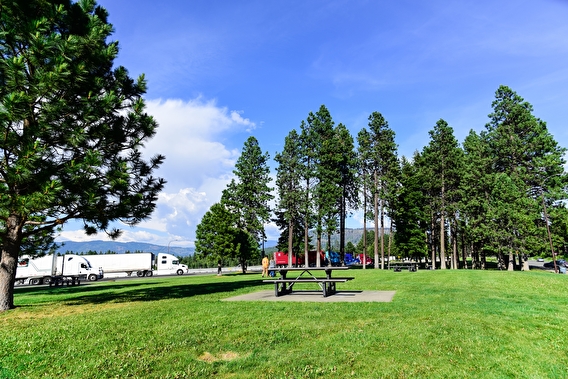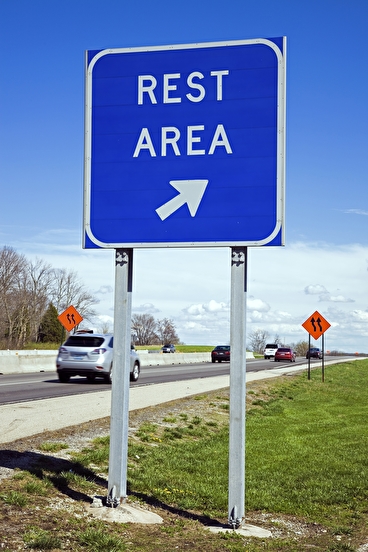
Managing wastewater and septic systems might not be the first thing you’d expect a transportation agency to deal with, but the Minnesota Department of Transportation (MnDOT) deals with a lot of it, operating 52 rest areas and truck stations across the state. Because of their locations, which are often in rural areas, most of these facilities are served by subsurface sewage treatment systems (SSTS), commonly known as septic systems.
“The nature of rest areas is that they are not close to towns—they’re often along an empty stretch of highway, so they are not able to be connected to municipal sewer and water, and the same is true for many of MnDOT’s truck stations,” says Sara Heger, a research associate and adjunct assistant professor with the U of M’s Water Resources Center. “Due to the aging infrastructure, many of these systems are also 30 years old or more. The question becomes: How do you prioritize upgrades, evaluate every system to avoid making assumptions, and develop a risk framework to help plan for the future?”
For nearly a decade, MnDOT has teamed up with the experts at the Water Resources Center to help answer these questions, working to better understand the treatment occurring at MnDOT’s SSTS and examine the impacts of wastewater on groundwater systems, soil, and vegetation.
The partnership began in 2014 with a first phase of research that involved gathering wastewater data from each rest area (including daily water flows, organics, and nutrients in the wastewater) and SSTS status (such as septic tank-pumping frequency, problems and challenges, and method of wastewater conveyance). This data was used to create a risk assessment and rating for each rest area.
“With this project, we were able to assess every facility in the same way to give us an apples-to-apples comparison,” says Neile Reider, principal engineer with MnDOT’s Water Services Unit. “This allowed us to begin taking a more proactive approach to SSTS management by identifying issues before they became emergencies.”
Following the initial system inventory, researchers continued to work on many follow-up research projects. Between 2015 and 2019, researchers monitored the water table in relation to SSTS to confirm that water treatment goals were being met; this information was used by MnDOT to help prioritize upgrades. In another initiative, they designed and placed signage at MnDOT rest areas to help educate the traveling public about the proper use of septic systems.
“One of the biggest challenges with users is what they sometimes put down the drain,” Heger says. “The outside signage helps them learn more about what septic systems are, and interior signs explain what should and shouldn’t be flushed.”

During this timeframe, researchers also conducted a water use study to determine rest area water use per person, investigated wastewater reuse for salt brine at truck stations, sampled flammable waste traps at truck stations, and conducted an analysis of toilet paper and water softener impacts on SSTS.
From MnDOT’s perspective, one of their key efforts involved developing operation and maintenance manuals for each SSTS. “These manuals cover the system organization, components, maintenance requirements, and troubleshooting tips,” Reider says. “This allows for continuity of knowledge as retirements occur and puts this important knowledge at the field operators’ fingertips.”
According to Reider, the work has led to benefits for both the agency and the traveling public. For example, when a drainfield at the Adrian Rest Area stopped working, operators were able to shut off the damaged zone and keep the rest area open while a new drainfield was constructed. He attributes the success to knowing exactly how each SSTS functions, along with redundancy and modifiable systems.
During the past four years, researchers have continued to monitor water tables and developed a reuse demonstration for wastewater in truck station flammable waste traps. In addition, they have begun looking at how chemicals of emerging concern—such as solvents, detergents, pharmaceuticals, agrochemicals, and hormones—move through SSTS. Going forward, they plan to continue these research initiatives as well as begin investigations of septage characteristics and disposal options, groundwater mounding, temperature monitoring, and septic tank performance modifications.
“From our perspective, this partnership has been great because we can continue to do research with these SSTS that are used year-round by a wide range of people at a consistent level and are very accessible,” Heger says.
Watch the CTS webinar recording: Evaluating Options for Wastewater Treatment at Rest Areas and Truck Stations.
—Megan Tsai, contributing writer